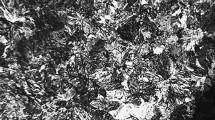Conclusions
Products made on the basis of granular bodies from zirconium dioxide that has been completely stabilized in the cubic form or containing the monoclinic phase in a very limited quantity (about 8–10%), are unstable and unacceptable for operations in conditions where sharp periodic temperature changes or a high temperature gradient are possible.
The presence of 20–40% monoclinic phase in the products guarantees a microcracked structure in the material, capable of resisting thermal impact. It also prevents growth in these microcracks during repeat heating and cooling of the material, as a result of volume changes connected with polymorphism of ZrO2.
The choice of the conditions for determining thermal shock resistance should be made bearing in mind the proposed service conditions for the material. Together with a determination of the thermal shock resistance using the heat-cycle method up to a weight loss of 20%, it is desirable to determine the residual strength of the material (tensile), and also to use the calculated coefficient of thermal expansion of the material obtained from its physicomechanical characteristics.
Similar content being viewed by others
Literature cited
R. Pampuch, Prace instytuton hutniczych, No. 13, 229 (1961).
O.I. Whitemore, D.W. Marshall, J. Amer. Ceram. Soc.,35, No. 4, 64 (1952).
N.C. Jones, Refractories J.,28, No. 5, 214 (1952).
A.G. Karaulov et al., Izv. Acad. Nauk SSSR, No. 6, 1101 (1967).
G.K. Basalova et al., Byull. Izobretenii, No. 10 (1958).
A.G. Karaulov and I.F. Usatikov, Ogneupory, No. 10, 436 (1964).
O.M. Margulis et al., Ogneupory, No. 2, 63 (1964).
L.T. Koshur, Inventor's Certificate No. 159754, dated 1962. Byull. Izobreteni, No. 1, 74 (1964).
O.M. Margulis, Collection of Scientific papers from the Ukrainian Refractories Research Institute (UN110) [in Russian], No. 4, 58 (1960).
A.G. Karaulov et al., ibid., No. 10 (1967).
A.G. Karaulov and V.Ya. Belik, ibid. No. 10 (1967).
I.A. Campbell, High Temperature Technology [Russian translation], IL (1959).
O. M. Margulis et al., Collection of Scientific Papers from UNIIO [in Russian] No. 3, 153 (1960).
V.M. Tsinkina, ibid., No. 3, 129 (1960).
G.P. Kalliga and L.A. Lyutsareva, Silicates and Oxides in High Temperature Chemistry [in Russian] Izd. ANSSR (1963), p. 173.
D.N. Poluboyarinov and E.S. Lukin, Ogneupory, No. 5, 230 (1962).
G.P. Kalliga, Casting Zirconia Refractories [in Russian], Izd. “Metallurgiya,” (1964).
H.E. Schwiete, RZhKh, Series 19M, No. 8, abstract 8M32 (1963).
A. G. Karaulov, Collection of Scientific Papers from UNIIO [in Russian], No. 5, 269 (1961).
A. G. Karaulov and G. V. Kukolev, Teor. i Tekhnol. Issled. v. Oblast Ogneuporov, No. 8, 167 (1965).
A. S. Berezhnoi, Ogneupory, No.7, 305 (1954).
GOST 7875-56.
A. A. Grebenyuk and Z. I. Zhuravleva, Collection of Scientific Papers from UNIIO [in Russian], Metallurgizdat, No. 2, 159 (1958).
G. A. Prantskyavichyus et al., Tr. AN Litovskoi; SSR, Series B, No.1 (44), 161 (1966).
I. S. Kainarskii and E. V. Degtyareva, Silicon Carbide Refractories [in Russian], Metallurgizdat (1963).
I. White, Trans. Brit. Ceram. Soc.,57, No. 10, 591 (1958).
I. S. Kainarskii and E. V. Degtyareva, Collection of Scientific Papers from UNIIO [in Russian], No. 4, 5 (1960).
G. V. Kukolev and I.I. Nemets, Zh. Vses. Khim. Obshchestva im. D. I. Mendeleev, No. 2, 155 (1963).
N. B. Mitchell, Materials Research and Stand,1, No. 10 (1961).
Detei. Silicates industr.,23, No. 3, 131 (1958), abstract RZhKh No. 5, 16166 (1959).
Y. A. Rubin, Ber. Dtsch. Keram. Ges., No.1, 13 (1963).
A. A. Grebenyuk, Tr. AN Litovskoi SSR, Series B, No.1 (48), 185 (1967).
Author information
Authors and Affiliations
Additional information
Translated from Ogneupory, No. 1, pp. 42–49, January, 1968.
Rights and permissions
About this article
Cite this article
Grebenyuk, A.A., Karaulov, A.G., Dauknis, V.I. et al. Effect of phase composition on the thermal shock resistance of zirconia. Refractories 9, 44–51 (1968). https://doi.org/10.1007/BF01286347
Issue Date:
DOI: https://doi.org/10.1007/BF01286347




